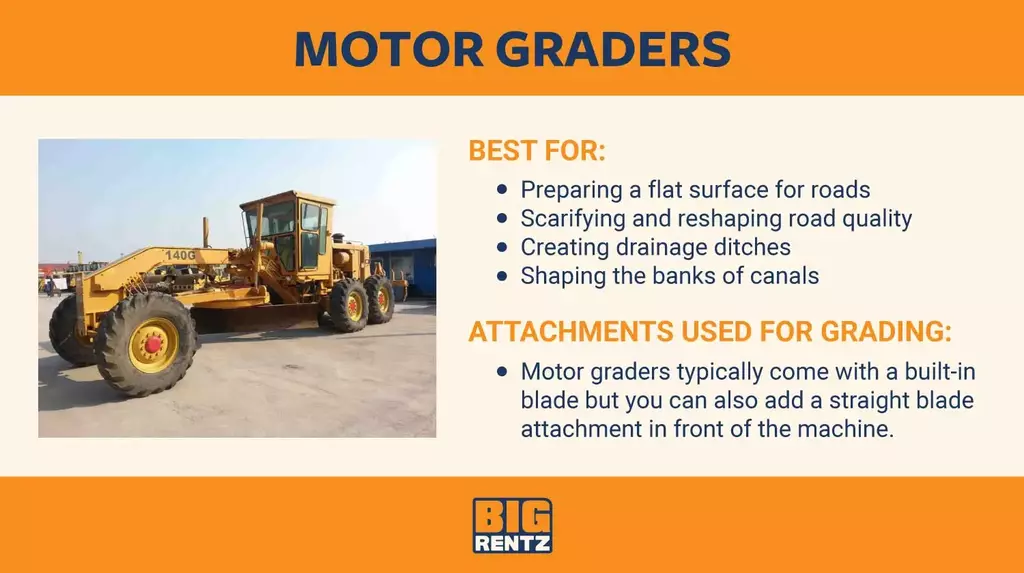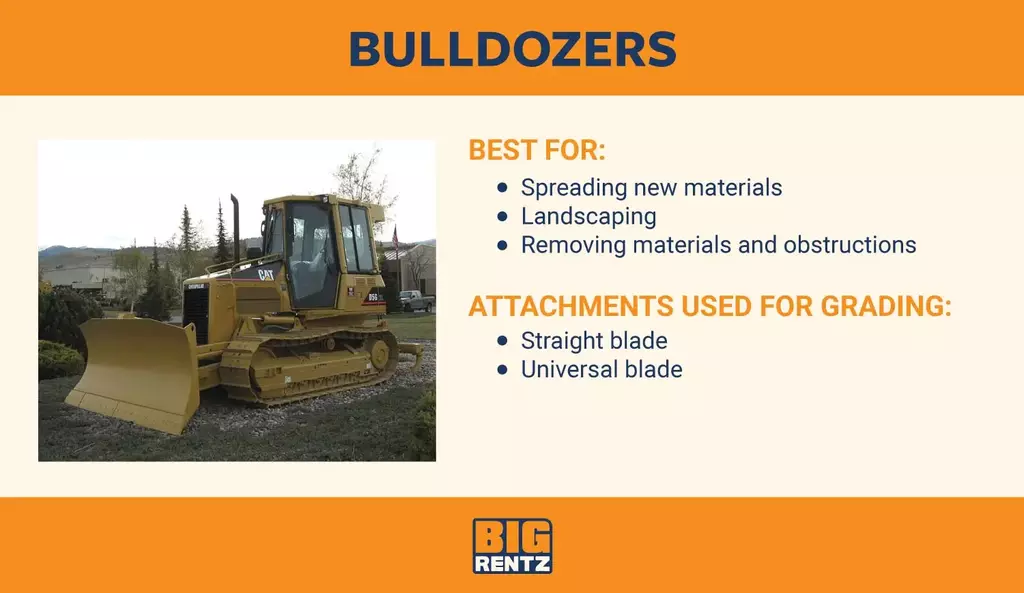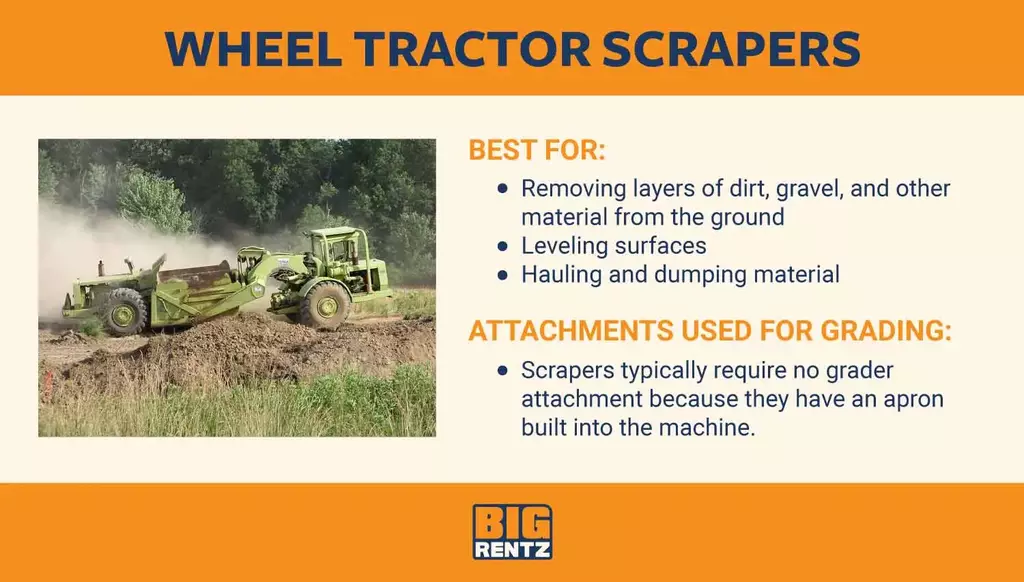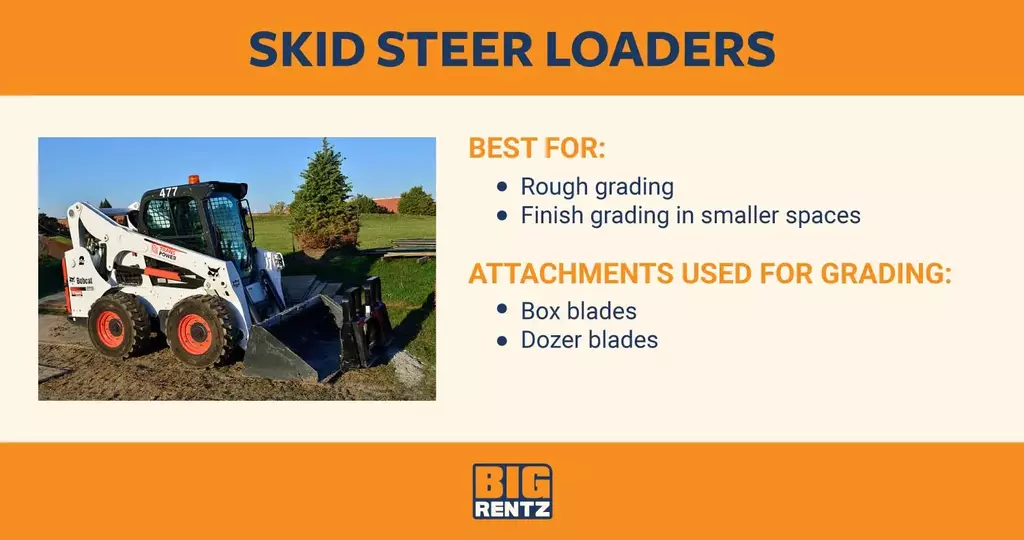The process of grading is often used to provide a level base or a specific slope. Grading can prepare land for landscaping or construction projects, establish new drainage patterns, or add to the landscape’s aesthetic. Grading often involves tasks like cutting into the ground surface, leveling, and filling by adding, removing, or moving dirt.
In this guide, we explain the best types of grading machines available and what to consider when starting a grading project.
Explore All Earthmoving Equipment
What Are the Best Types of Equipment for Grading?
Though many pieces of heavy equipment are versatile, choosing the right machinery for your specific grading project will make your job easier and more efficient.
Motor Graders
Originally designed for road construction and maintenance, motor graders excel at efficient, high-precision grading. A variety of industries—including construction, mining, landscaping, and roadwork—utilize graders for tasks such as leveling surfaces, setting foundations for buildings, spreading materials, digging ditches, constructing slopes, and more. Their versatility, efficiency, and maneuverability (in the case of modern articulated frame graders) make motor graders a useful machine for a variety of projects.
Because motor graders have rubber tires, they offer solid traction on a variety of surfaces and can work at rapid speeds. You can also drive graders on the road, which makes them convenient to move between job sites. While the size of motor graders may limit them to larger projects, their main drawback is that they require skilled operators with experience. Some consider graders one of the more difficult machines to learn to operate, which may not make it the best choice for newcomers to the construction industry.

Best for:
- Preparing a flat surface for roads, buildings, or equipment
- Scarifying and reshaping roads for quality and drainage
- Creating drainage ditches
- Shaping the banks of canals
Attachments:
- Motor graders typically come with a built-in blade to scrape the ground; they do not require a special attachment for grading.
- Straight blade: Is an attachment available in multiple widths and heights for various applications. It can be attached to the front of the machine and is effective for grading, snow removal, land-leveling and dozing.
Bulldozers
Powerful earthmoving machines, bulldozers can use their front blade to perform all sorts of grading operations—from leveling the land for roads, buildings, landscaping, and railways to putting the finishing touches on already graded surfaces. Some dozers have technology applications such as grade control, which automates blade control to improve the accuracy and speed of any grading project.
One of the bulldozer’s biggest advantages comes from the sheer number of attachments you can use, including grader blades of varying sizes and materials. On the other hand, the bulldozer is heavy construction equipment not designed for precision work. If you need a machine that can perform fine grading and minimizes damage to the surrounding environment (such as trees and soil), a dozer may not make the best choice.

Explore All Bulldozers
Best for:
- Spreading new materials
- Landscaping
- Removing materials and obstructions
Attachments:
- Straight blade: Also known as an S-blade, this short blade works well for fine materials and light grading.
- Universal blade: Sometimes called a U-blade, the universal blade has a taller, wider, curved shape and side wings. They excel at pushing materials, even over long distances.
Wheel Tractor Scrapers
Wheel tractor scrapers consist of a tractor in front and hopper (or bowl) in the rear. As the tractor moves forward, a horizontal blade cuts into the soil and fills the bowl. After completing their grading job, scrapers can also transport the collected material to another location.
The downside of some scrapers—such as single engine scrapers or non-motorized pull-type scrapers—is that they might require an additional machine to support them, especially on rougher terrain. On the other hand, the multipurpose scraper can perform several tasks in a single pass: leveling, collecting, hauling, and dumping the material. So you don’t have to rent other equipment, such as a dump truck, to complete the job. Scrapers also hold a strong advantage when it comes to scraping wet soil—no other earthmoving machine can compare.

Best for:
- Removing layers of dirt, gravel, and other material from the ground
- Leveling surfaces
- Hauling and dumping material
Attachments:
- Because scrapers have a built-in blade to scrape the ground, they do not require a special attachment for grading.
Skid Steer Loaders
These compact, versatile, self-propelled machines perform big jobs in small spaces. Skid steers can help out on small-scale grading projects, such as landscaping, residential lots, and backfilling.
Loaders come with buckets in the front, which can shovel materials and allow operators to specially position or connect to hydraulic attachments to improve the grading result. These strategies help transfer weight forward, preventing the front of the machine from coming off the ground and keeping the track in full contact for greater traction.
As compact but heavy equipment, skid steer loaders can have a problem with ground pressure. You may find it difficult to use some skid steers to grade without leaving noticeable tracks, especially in softer surfaces. Additionally, as the name suggests, skid steers skid on surfaces when turning because their front and back wheels are mechanically connected.
They aren’t steerable like wheel loaders. On the flip side, the advantages of skid steer loaders include the fact they have a variety of good attachments for grading, their ability to go over finished surfaces, and of course their durability for big tasks in small spaces.

Explore All Skid Steers
Best for:
- Rough grading
- Finish grading in smaller spaces
Attachments:
- Box blades: A box blade attachment can help skid steers work on concrete subgrade, parking lots, and fine grading.
- Dozer blades: Dozer blade skid steer attachments make it easy to do small-scale rough and finish grading at landscaping or construction sites.
How to Choose the Best Grading Equipment
When choosing the correct grading equipment for your job, you will want to consider various factors such as the nature of the grading project and the characteristics of the equipment.
Type of Grading
Knowing what type of grading tasks you need to complete makes it easier to choose the right machine for the job.
- Landscape grading: Landscape grading reshapes land to create smooth areas for planting, ensure proper drainage, alter elevations, and install irrigation systems. A variety of municipal, commercial, and residential landscape projects of varying sizes require landscape grading.
- Architectural grading: An essential part of the building process, architectural grading prepares the land for the construction of new homes or buildings. This process adjusts the soil’s slope and elevation to ensure a proper foundation and drainage.
- Regrading: Regrading involves lowering or raising the levels of an area of land. Crews can regrade small projects or large land developments.
- Rough grading: Rough grading sets the basic shape, slope, and elevation of an area. Crews may perform rough grading to level the ground for development, prepare an area for landscaping, or establish or correct drainage flow. This often includes adding, moving, or removing soil.
- Finish grading: Finish grading involves putting the final touches on an already-graded area. For specific purposes such as gravel roads and earthworks projects, grading may include the surface of the completed construction, not just the base. After rough grading cuts the desired slope and removes any rocks, stumps, or other debris, finish grading creates a smooth top surface.
- Final grading: Final grading finishes the grading process by preparing the area for final landscaping or seeding. During this step, graders cover the area with a special material designed to promote growth, such as screened topsoil.
Consider the Type of Grading Attachment
Equipment designed to grade, like motor graders and scrapers, come with grading blades built into the machine. Other vehicles, however, such as compact track loaders require attachments to effectively perform grading projects.
The Size of the Equipment
Motor graders or wheel tractor scrapers may fit the bill for large-scale grading projects on construction sites, farms, and highways. If you’re working in small residential areas, however, you may consider more compact landscaping equipment like skid steer loaders.
Try Renting Grading Equipment
If your next project calls for land grading, several types of construction vehicles can get the job done. Whatever the task, BigRentz has the grading equipment you need—from bulldozers and backhoes to skid steers and trenchers—in varying sizes and powers to suit all sorts of requirements.
Explore All Earthmoving Equipment